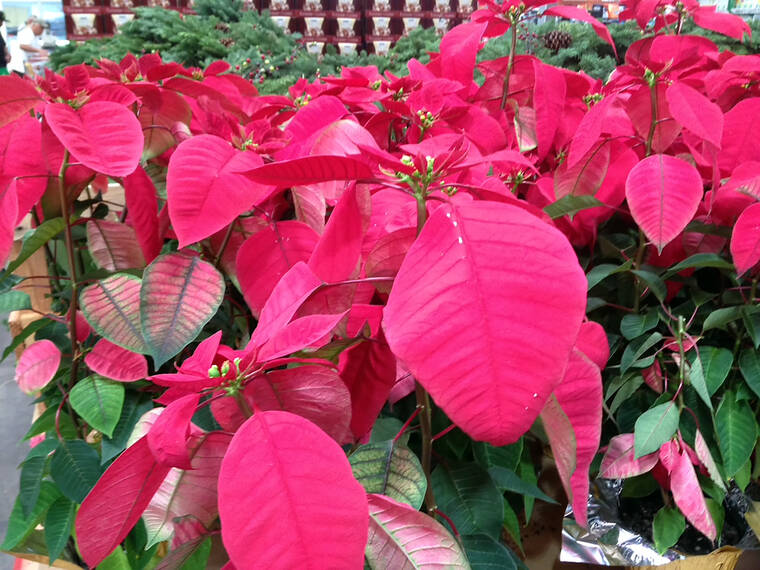Although we have been seeing Christmas decorations in some stores, the Christmas holidays don’t seem real until our Thanksgiving leftovers are thoroughly digested.
Poinsettias especially in dryer Kona, Ka‘u and Kohala will soon be in spectacular color. Although mainland folks think of the poinsettia as a Christmas flower, for us it blooms November through March. They are originally from dryer regions of Mexico so do best with less rain during their flowering season. The poinsettia, or Euphorbia pulcherrima, was introduced to the United States in 1828 by Joel Roberts Poinsett, a botanist and first US Ambassador to Mexico. There it is known as “La Flor de la Nochebuena” or Flower of the Holy Night. Today, Christmas would not be Christmas without the poinsettia.
So if you don’t have a showy supply in your home and garden for Christmas, they are now available at stores, nurseries and garden centers.
Purchasing potted stock from a garden center or nursery is the easiest way to establish plantings of the holiday ornamental. There are a number of poinsettias available. They come in traditional reds or you can enjoy color combinations indoors and in the garden if you mingle the red plantings with white and pink varieties.
Poinsettias will grow on a wide range of soils, including sand, rocky soil and clay. In spite of the wide adaptability, the plants will present you a better show of color if you take proper care of them.
In massed beds, fertilizer application is important. An application of fertilizer in August should now be producing large colorful bracts. The plants need repeat applications of plant food in early spring, again in June and perhaps during mid-summer if there are heavy rains.
For best results, prune poinsettias back in late winter or early spring after blooming is over. Cut them back to within 12 to 18 inches of the ground.
You’ll find that a compact plant will furnish more color than a plant with few unbranched stalks. To promote a riot of colored bracts, prune the plants several times during the growing season. Nip the new growth back after it is 12 inches long, leaving four leaves on each shoot. Be sure to stop the pruning in early September, because the flowering buds are set in early October.
Poinsettias show their color according to the day length and temperature. A plant near a lighted window or a street light often refuses to color up like a neighboring plant in a nearby darker corner. Dreary skies in September and early October will shorten the days causing plants to set buds and flower before the holiday season.
You will find that temperature is a limiting factor for a good show of flowers. If the night temperatures are much above 70 degrees, bud formation will be retarded. Freak periods of hot weather during this critical time may not permit buds to form at all. The best flower development is when the night temperatures range from 60 to 68 degrees. This year has been somewhat warm temperatures at lower elevations are retarding flower formation, but upland regions have been ideal for a riot of color.
For plants in your garden, one problem to watch for now are mites. Dryer conditions are ideal for this pest. Spraying with a miticide will take care of the little stinkers. If you want to avoid sprays, sprinkling the leaves daily with the garden hose is helpful. This will also minimize whitefly attacks. Avoid sprinkling in the heat of the day.
If you want to experiment with this year’s potted plant, don’t toss it out when the last leaf drops.
The plant will show brilliant color next Christmas season if you follow these tips. First, store the pot, plant and all, in an out of the way place. This treatment is intended to force the plant to hibernate during the cool days while the shriveling top feeds the sleeping roots.
Only water the plant to keep it from getting bone dry. Avoid giving it fertilizer. Try storing the sleeping plant in the shady corner of the carport.
Toward the end of February, tenderly awake the plant by cutting off the dead top. You can grow the new plant in last season’s pot, but the poinsettia will be happier if you set it in the ground where it can flex its roots better than in the confines of a pot. Make sure you plant it where it will get lots of sun and a well drained soil.
If you want to learn more tropical gardening tricks and techniques consider becoming a UH master gardener. For more information call 808-981-5199 at the Hilo Komohana Agriculture Complex or Ty McDonald in Kona at 322-4893.

